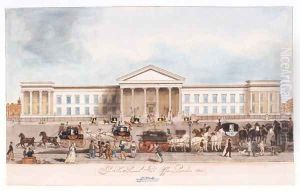James Thomson Paintings
James Thomson was a Scottish poet and playwright, best known for his masterpiece 'The Seasons', a series of four long poems that reflect the various stages of the natural year: 'Winter' (published in 1726), 'Summer' (1727), 'Spring' (1728), and 'Autumn' (1730), which was added to later editions. His poetry is noted for its rich descriptions of the natural world and its changes, which also reflect the emotional and philosophical contemplations of man's place in the universe.
Thomson was born in Ednam in Roxburghshire around September 11, 1700. His father was a minister and his mother the daughter of a minister, so he was steeped in a religious and scholarly environment from an early age. He attended Jedburgh Grammar School and later, in 1715, went on to study at the University of Edinburgh. Initially, he trained to become a minister, but his passion for poetry led him down a different path. He moved to London in 1725, where he worked as a tutor and started to make a name for himself as a poet.
Apart from 'The Seasons', Thomson is also remembered for 'The Castle of Indolence' (1748), an allegorical poem written in Spenserian stanzas that explores themes of idleness and industry, a popular subject in the literature of the Enlightenment. Additionally, Thomson wrote the lyrics for 'Rule, Britannia!', which was set to music by Thomas Arne and became an enduring patriotic anthem in Britain.
Thomson's work was highly influential in his time and helped to shape the burgeoning Romantic movement, despite the fact that he lived most of his life in the Augustan age. His focus on nature, emotion, and the individual's experience of the sublime had a lasting impact on later poets, including William Wordsworth and Samuel Taylor Coleridge.
James Thomson never married and suffered from ill health in the later years of his life. He died on August 27, 1748, in Richmond upon Thames, and was buried in the churchyard of St. Mary's, Richmond. His work continued to be read and appreciated after his death, securing his place as a significant figure in British literary history.
